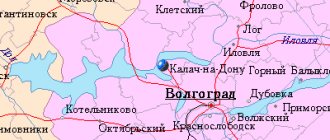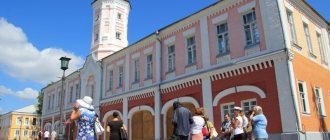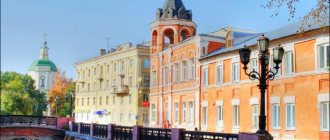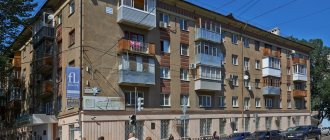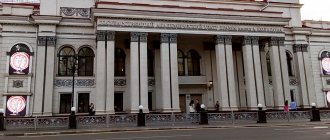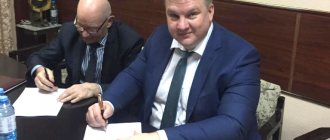VORONEZH
VORONEZH, a city in Russia, the administrative center of the Voronezh region, forms an urban district. Population 1058.3 thousand people. (2019; 877.9 thousand people in 2010; 886.8 thousand people in 1989; 447.2 thousand people in 1959); together with the suburbs it forms an agglomeration with a population of over 1.3 million people. (2018). Located on the border of the Central Russian Upland and the Oka-Don Plain, on the Voronezh River, near its confluence with the Don River. A large transport hub. The Don highway (Moscow - Rostov-on-Don) and the Kursk-Voronezh-Saratov highway pass through V.; The Voronezh-Tambov highway begins here. Junction of railway lines to Moscow, Rostov-on-Don and Kastornaya station; three railway stations (Voronezh-I, Voronezh-Kursky and Pridacha). Chertovitskoye International Airport (1933; 853.6 thousand passengers in 2019; also carries out cargo transportation).
Story
Founded in the fall of 1585 as a fortress (builder and first governor of V. - S. F. Saburov Papin) on the southwestern border of the Russian state for protection from the Crimean and Nogai Tatars, in 1590 it was burned by them. The fortress was restored in 1594. In the mid-17th century, due to the construction of the Belgorod area, it lost its military significance, turning into a trade and craft center. In 1696, under the leadership of F. M. Apraksin, the construction of the Russian navy began in Vietnam (including ships that took part in the 2nd Azov campaign of 1696). In 1705–69 (with interruptions), the main work was carried out at the shipyard in the city of Tavrov (now within the boundaries of V.). In 1708–15 a district city, in 1715–25 the center of the Azov province, in 1725–1928 – the Voronezh province (in 1779–96 – the Voronezh governorship). At 18 – mid. 19th centuries one of the key centers of cloth production in Central Russia (Gardenin and Tulinov manufactories). The lines of the Kozlovo-Voronezh (1868), Voronezh-Rostov (1871), and Kiev-Voronezh (1894) railways passed through V. In the 2nd half. 19th – early 20th centuries V. turned into one of the largest industrial cities in Central Russia. In 1879, the congress of “Land and Freedom” of the 1870s took place in V. Oct 30 (Nov. 12) 1917 owl was installed in the city. power. In Oct. 1919 occupied by the corps of Lieutenant General A.G. Shkuro, in the same month, during the Voronezh-Kastornensky operation of 1919, it was taken by units of the Workers 'and Peasants' Red Army. In 1928–34 the center of the Central Chernozem region, from 1934 - the Voronezh region. In the 1930s it included the left bank of the Voronezh River. During the Great Patriotic War, from Oct. From 1941 to May 1942, the headquarters of the Main Command of the troops of the South-Western direction and the South-Western Front was located in V. On July 6, 1942, the right bank part of the city was occupied by German troops and liberated on January 25, 1943, during the Voronezh-Kastornenskoye operation. As a result of the fighting, approx. 90% of the city's housing stock has been restored to the middle. 1950s City of Military Glory (2008).
Architecture
Voronezh. Intercession Cathedral. 1833–41. Architect I. A. Blitsyn (?). Bell tower. 1791.
Voronezh. A stone bridge. 1826. Architect I. A. Blitsyn. Photo by A. I. Nagaev
Voronezh. Monument to I. S. Nikitin. 1911. Artist I. A. Shuklin. Post card. 1910s
The basis for the restoration of V. after the Great Patriotic War was the general plan of 1946 (architect L. V. Rudnev and a group of Voronezh architects). Former examples of the constructivist style were reconstructed in classic forms (Administration of the South-Eastern Railways, 1928–32, 1952, architect N.V. Troitsky; “Iron” house, 1930–34, architect A.I. Popov-Shaman, 1955–1957 , architect V. S. Levitsky; one of the buildings of the Central Black Earth Engineering University). Among the architectural monuments: Baroque churches - Resurrection (1761–68), Introduction (1770–80), Nikolskaya (1712–20; rebuilt in 1749–55); houses in the Baroque style (of the merchant Savostyanov and governor Potapov - palace type); State Chamber (1786–87; project by G. Quarenghi, construction was supervised by provincial architect I. I. Volkov; rebuilt after the Great Patriotic War), Intercession Cathedral (1833–41, possibly architect I. A. Blitsyn; bell tower - 1791) and mansions (Tulinov, Nenarokomov, so-called Martynov house) - in the style of classicism. The Akatov convent in the name of St. Alexy of Moscow unites buildings from the 17th–19th centuries. and modern buildings (founded in 1620, restored in 1990; St. Alexis 2-story church, 1804–19, 1844; hipped bell tower, 1674, etc.). The historical buildings of V. are dominated by architectural structures of the 2nd half. 19–20 centuries, including buildings in the forms of neoclassicism (architect M. N. Zamyatnin and others) and neo-baroque (main building of the Agrarian University named after Emperor Peter I, 1913–16; engineers A. I. Dietrich, V V. Sokolovsky); the Bristol Hotel was built in the Art Nouveau style (1909–10, engineer M. E. Furmanov), etc. Monuments: Peter I (1860; sculptor A. E. Schwartz, architect A. A. Cui; statue restored in 1956, sculptor N. P. Gavrilov), A. V. Koltsov (1868, sculptor A. Triskorni), Victims of the White Terror (1929, architect Popov-Shaman), V. I. Lenin (1940, sculptor N. V. Tomsky; restored in 1950), I. S. Nikitin (1911, artist I. A. Shuklin), etc. Memorials of the Great Patriotic War: “Rotunda” (ruins of one of the hospital buildings with a memorial square, 1960–80s), “Chizhovsky bridgehead" (1975; sculptors A. A. and O. P. Tolmachev, architect V. K. Selyutin), etc.
Science and education
V. is the largest center of science and education in the Central Black Earth Region. Operating: Voronezh branch of GiprodorNII (1933; design and survey work for the construction, reconstruction and repair of highways and artificial structures); Chemical Automatics Design Bureau (1941; development of liquid rocket engines); several research institutions as part of the Sozvezdie concern (2004) on the basis of the Communications Research Institute (1958; R&D in the radio-electronic industry), including the Vega Research Institute (1956; development of communications equipment), the Semiconductor Engineering Research Institute (1961 ) and electronic engineering (1983), (1931); Research Institute: economics and organization of the agro-industrial complex of the Central Black Earth Region of the Russian Federation (1930; in 1930–34 Institute of Socialist Reconstruction of Agriculture; in 1934–55 Institute of Agricultural Economics, in 1955–88 branch of the All-Russian Research Institute of Agricultural Economy), feed industry (1961), forest genetics , selection and biotechnology (1970), veterinary research institute of pathology, pharmacology and therapy of the Russian Agricultural Academy (1971); Central Chernozem Research Institute Giprozem; Mekhanotroniki-Alpha-NC (1992; development of medical equipment), automated production and control equipment (2007); security; RosdorNII; “Modern technologies of examination”, Research Institute Avtogenmash, “Hydroaerocenter” (development of oil and gas equipment); Research and Production Enterprise "ERA" (1990; development and implementation of new technical solutions in the field of industrial power supply); State Research Testing Institute for Problems of Technical Information Protection FSTEC of Russia (2000); a number of research institutes within VSU (physics, mathematics, chemistry, geology, economics); branch of the St. Petersburg Research Institute of Synthetic Rubber named after Academician S.V. Lebedev (1959), etc.
Universities: Voronezh State University [established in 1918 on the basis of the evacuated Dorpat (Tartu) University; it includes the Botanical Garden named after Professor B. M. Kozo-Polyansky, 1937]; Voronezh State Medical University named after N. N. Burdenko (established in 1918 on the basis of the evacuated Russian department of the Faculty of Medicine of the University of Dorpat; since 1930 medical institute; since 1994 Medical Academy named after N. N. Burdenko; modern name and status since 2015) , Voronezh State Technical University (1956; current name since 1993; since 2021 it has the status of a flagship university of the Voronezh region with the addition of the Voronezh State University of Architecture and Civil Engineering), Voronezh State Agrarian University named after Emperor Peter I (established in 1912; opened in 1913; current name since 2011), Voronezh State Forestry University named after G. F. Morozov (1930; current name since 2015 - Voronezh Forestry Institute, Voronezh State Forestry Academy), Voronezh State Pedagogical University (1931; current name . since 1993), Voronezh State University of Engineering Technologies (in 1930–32 Voronezh Institute of Food Industry, in 1932–47 Voronezh Chemical Technology Institute, in 1947–59 transferred to Leningrad, became part of the Leningrad Technological Institute of Food Industry, in 1959– 94 Voronezh Technological Institute, in 1994–2011 Voronezh State Technological Academy, modern. name and status since 2011), Air Force Academy named after N. E. Zhukovsky and Yu. A. Gagarin (1950); Voronezh State Institute of Arts (1971), Voronezh State Institute of Physical Culture, Voronezh Institute of the Ministry of Internal Affairs of Russia (both - 1979), Voronezh Institute of the Federal Penitentiary Service (2001), Voronezh Institute of the State Fire Service (2008); branches: Moscow State University of Transport, Russian University of Economics named after G.V. Plekhanov, Russian Academy of National Economy and Public Administration under the President of the Russian Federation, Russian State Social University (all Moscow), State University of Maritime and River Fleet named after Admiral S. O Makarov (St. Petersburg), Russian State University of Justice; Academy of the Federal Security Service of the Russian Federation (Institute of Government Communications; both - Moscow). Choreographic School (1938), Art School (1939). Theological Seminary (1745; closed in 1918; recreated in 1993).
Libraries: central named after A.P. Platonov (history dates back to 1834 with the first free public library; central status since 1965; in 1988 it was named after the native V.A.P. Platonov; in 1978 a centralized library system was created on its basis), universal scientific named after I. S. Nikitin (1864), zonal scientific VSU (1918), youth library named after V. M. Kubanev, specialized for the blind named after V. G. Korolenko (both - 1954), special city art library named after A. S. Pushkin (1959), central city children's room named after S. Ya. Marshak (1966), city named after G. N. Troepolsky (1968), city Orthodox, etc. State Archives of the Voronezh Region (1919).
Cultural centers
Among the most important museums in the city are the local history museum (1894), which includes the “Goto Predestination Museum Ship” (2014); regional literary named after I. S. Nikitin [1924; originally in the house of I. S. Nikitin; reorganized in 1994; now it includes the main building (the former Provincial Museum, 1894), the house-museum of I. S. Nikitin, the estate of the poet D. V. Venevitinov and the museum-apartment of the singer M. N. Mordasova (2005)], the regional art museum named after I. N. Kramskoy (1933), “Arsenal” (1983; in a building from the 1770s, the exhibition is dedicated to the Great Patriotic War). House-museum of trainer A.L. Durov (1978). Center for military-patriotic education “Museum-Diorama” (2000). Voronezh Opera and Ballet Theater. Academic Drama Theater named after A.V. Koltsov (1802). Puppet theater "Jester" (1925). Theater for Young Spectators (1932–41; revived in 1963). Chamber Theater (1993).
Voronezh Russian folk choir. Voronezh Regional Philharmonic (founded in 1937, since 1961 in the current building built in 1908) with a Concert Hall with 460 seats; It includes the Voronezh Academic Symphony Orchestra (1925) and other academic and folk groups. Pop choir “Russian format” under the direction of S. Dubanov (2008). The cultural institution “Voronezh Concert Hall” (2012) has a Large (782 seats) and a Small (178 seats) halls. Circus (dating back to 1882; in a modern building since 1975). International festivals: “Jazz Province” (since 2003), Platonov Arts (since 2011; both annually), Other festivals: All-Russian Japanese Animation (since 2000), Russian song “Golden Outskirts” named after A.I. Tokmakov (since 2005) , poetry "Poetekh" (since 2007), Regional National Cultures "Voronezh Multinational" (since 2011), Christmas Sacred Music (since 2012), regional festival "Theater Syndrome" (since 2014). Zoo (1994). City parks: Central Culture and Recreation (1929), “Eaglet” (1954), etc.
Sport
Among the sports facilities is the Central Trade Union Stadium (built in 1934; modern name since 1973; 32.8 thousand seats, home to the Fakel football club, 1947, modern name since 1977); "Dynamo" stadium (1932; 5 thousand seats), "Chaika" sports and recreation complex (1953), "Lokomotiv"; ice sports palace "Yubileiny" (1986; 3 thousand seats; the ice hockey club "Buran" hosts its rivals, 1977). The most titled club in the city is the women's football club “Energia” (1989): 5-time champion of Russia (from 1995 to 2003), 6 times silver and 3 bronze medalist of the championship, 7-time winner of the National Cup (1993–2001) .
Farm
The basis of the city economy is the service sector; its leading sectors are: administrative, financial, transport and logistics services, trade, science, education and healthcare. V. accounts for 62.2% of the retail trade turnover of the Voronezh region (364.5 billion rubles, 2019), 66.3% of the public catering turnover and almost 87% of the turnover of paid services in the region.
Large industrial center. Main industries: mechanical engineering, chemical, metallurgy and metalworking and food processing. A significant part of machine-building enterprises is closely connected with the defense industry. The radio-electronic industry is represented by the Sozvezdie concern [2004; production of complexes, systems and communications equipment for the armed forces of the Russian Federation; it includes: Voronezh Research Institute "Vega" (design of control and communication systems for military and civilian purposes)] and (1931; the latest radio communications equipment in the short-wave, ultra-short-wave and microwave ranges for law enforcement agencies and general technical applications, components and parts of radio-electronic equipment) . Other large enterprises of the same profile include research institutes: electronic engineering (NIIET; production of microcontrollers and other integrated circuits) and semiconductor engineering (NIIPM; 1961; special equipment for the production of microelectronic equipment), Voronezh Semiconductor Devices Plant-Assembly (2002; radio-electronic technology). The development of high-tech software is carried out by defense industry enterprises: the Group (1990; modern database management systems) and the Special Design and Technology Bureau "Systemprogram". Medical instruments for endosurgery are produced by the research and production department (1992).
Leading enterprises of the aerospace industry: Voronezh Joint-Stock Aircraft Manufacturing Company (“VASO”, founded in 1932 as the Voronezh Aviation Plant, modern name since 1993; part of the United Aircraft Corporation; production of civil aircraft, Il-112 transport aircraft and aircraft components ), (1956; instruments and systems for aircraft) and mechanical (founded in 1928 as a plant for the production of cleaning machines, since 1940 production of aircraft engines, since 2007 as part of the State Space Research and Production Center named after M. V. Khrunichev; aviation , underground, lifting equipment); “Design Bureau of Chemical Automatics” (founded in 1940 in Moscow as Design Bureau-2, transferred to Voronezh in 1946, modern name since 1966; full cycle of creating liquid rocket engines), “Experimental Design Bureau of Motor Engineering” (founded in 1959 as part of the Voronezh mechanical plant No. 154, the status of an independent enterprise since 1960; gear-joint group units for aircraft; the only specialized enterprise in the country) and a research institute for automated production and control equipment (laser cutting machines).
Among the heavy engineering enterprises are the following factories: heavy mechanical presses (“Tyazhmekhpress”; 1953; one of the world’s largest specialized enterprises; production of automatic press lines, automated and mechanized complexes for forging and sheet metal stamping production, construction and car-wheel workshops, as well as large-sized metal structures), "Rudgormash" (1939; drilling, mining and mining equipment), machine tool (VSZ; 1960; production of grinding, milling and turning machines), "Gidrogas" (1996; pumps, shut-off and control valves, chemical capacitive equipment, etc.), Avtolitmash (1999; spare parts and components made of bronze and cast iron; capacity 2.4 thousand tons of products per year).
Among the leading enterprises in agricultural engineering are (1917; modern name since 1943; production of equipment for grain processing: cleaning, drying, transportation and storage) and the “Head Specialized Design Bureau “Zernoochistka”” (1956; production of grain cleaning, elevator equipment and optical sorters ).
There are also several repair plants: car repair plant named after E. Thälmann (1912; branch; repair of freight and passenger cars, production of spare parts, parts and components, freight and passenger bogies), diesel locomotive repair plant (founded in 1868 as railway workshops; branch; major repairs of diesel locomotives) , 172nd Central Automobile Repair Plant (1945; repair of automotive equipment, production of spare parts, components and assemblies).
Among the leading metallurgical enterprises are the Voronezh Metallurgical Plant (2006; production of long products), TS Foundry (founded in 2000 as TS Engineering, current status and name since 2016; iron and steel casting). The casting of church bells is traditionally developed (Bell Foundry of V.N. Anisimov; workshop of artistic and monumental casting “Monument”; artistic foundry of B.A. Podorozhny).
Among the chemical industry enterprises are (production of synthetic rubber), the Amtel-Chernozemye tire complex (both production of tires), the Voronezh-PLAST polyethylene pipe plant, factories: chemical-pharmaceutical "Veropharm" and polymer toys.
Light industry is represented by the knitwear manufactory, Dream World and a branch of the Kalyaev fur factory (Moscow).
Food flavoring - flour mills, meat and dairy plants, the Voronezh Yeast plant (in the French structure), factories: processed cheese "Yantar", Sazhinsky confectionery plant (formerly VKK "Don"), confectionery factories "Voronezhskaya" (as part of the holding " United Confectioners"), "Vizher" and brewery. There is a tobacco factory and an experimental feed mill.
The production of building materials and structures is carried out by enterprises of the following companies: Voronezh Construction Materials Plant (VKSM; 1954; sand-lime brick, gas silicate blocks, paving slabs), glass container plant (branch). Factory of musical instruments "Akko" (production of button accordions and accordions).
Energy supply is provided by: CHPP-1 (1933; installed capacity 168 MW) and CHPP-2 (1957; 127 MW; both use natural gas as fuel). Near V. - Novovoronezh Nuclear Power Plant (Novovoronezh; 1964; installed capacity 1834 MW) and the Voronezh Natural Biosphere Reserve named after V. M. Peskov (1923).
Founding of Voronezh
The region where Voronezh is located has been called the Voronezh province since 1725, which occupied vast areas from Azov proper in the south to Murom in the north. The city gradually developed, a theological seminary appeared in which the lower clergy were trained.
Like all Russian cities, Voronezh was built up mainly with wooden houses and this created a high risk of fires, the worst of which happened on May 10, 1748. The entire historical center, located on the river bank, was destroyed by fire, but soon the city was rebuilt again on the site of the current University Square.
The city also occupied an important place during the Patriotic War of 1812, when recruits arrived in the city from nearby provinces to join the resistance. The region where the city of Voronezh is located was not occupied by enemy troops at that time, so it was here that collections of money and uniforms for volunteers took place.
Population
Voronezh is a large city, but it does not reach the status of a metropolis. This is all due to the low level of income of people, the constant influx of migrants and the high percentage of elderly people. With low income, Voronezh residents are in no hurry to start a family, and therefore a demographic crisis in populated areas is possible.
Finding a job is not so difficult, but you will have to look for a job with career growth and a good salary.
The average salary increased 2.5 times compared to 2014 and amounted to 32 thousand rubles.
In Novovoronezh, which is called the city of peaceful atoms, with a population of 37 thousand people, salaries are even higher. It averages 35 thousand rubles. But the work here is dangerous; the bulk of the population works at the Novovoronezh nuclear power plant. The average duration is not encouraging: for men it is 40 years, and for women it reaches 57.
Ecology of the city and region
Voronezh is one of the largest industrial centers of the central Black Earth Region. Considering that a significant number of industrial enterprises are concentrated in a relatively limited area, there is nothing surprising in the tense environmental situation that has developed in the city.
In addition to enterprises, the large number of vehicles and frequent traffic jams also contribute to air pollution in the city. Traffic in the city is difficult due to the large number of minibuses and a small number of electric transport routes. Today there are several trolleybus routes in the city, and the tram was completely eliminated in 2009.
Climate of the Voronezh region
The region where the city of Voronezh is located is located on the territory of the European part of Russia, on the border of the Oka-Don Upland. Due to this, the terrain of the region is hilly and rugged.
As for the climate, the region where the city of Voronezh is located belongs to the temperate climate zone with moderately frosty winters, which are considered slightly warmer than Moscow, and warm summers.
In winter, abundant snow cover remains stable throughout the entire Voronezh region, which, however, does not form earlier than mid-December. Quite often in winter the temperature drops to twenty degrees below zero. Such temperatures can last up to a week or more. Among the summer months, July is considered the hottest, at the beginning of which temperatures can reach thirty degrees. However, in general, summers are considered moderately warm and dry. It is worth noting that the average annual temperature in the region where Voronezh is located is 6.5 degrees Celsius.
Administrative division into districts
The city is divided into six large districts. Two of them, Levoberezhny and Zheleznodorozhny, are located on the left bank of the Don. The residential buildings here are quite old, although Voronezh developers are now actively developing this territory. The population mainly consists of workers from factories and research institutes. The people are friendly and flexible. Families have little income
There is a black district called Koldunovka, where, according to rumors, sorcerers and witches live. By the way, there is also Drunken Street, where moonshine is always sold. All names say:
- Pasture - where horses were sold,
- Kresty is an area next to the cemetery. On the outskirts of the left bank there are holiday villages.
This whole picturesque picture ends in an area called Mashmet. He has long gained notoriety. People say bandits live here. People say it's scary to leave the house here. There have always been many Caucasian and Gypsy families here who interfere with the quiet life of people.
The counterbalance to Mashmet is the VAI region, which is between the Shinny plant, thermal power plant and SK. The microclimate in the area does not please people. Visitors rarely want to settle here. Too far from the center, and the neighborhood does not inspire confidence. These areas always appear in crime reports; it is dangerous to live here. However, development in the areas is active. Housing here is cheaper to buy and rent. Selskaya Street offers houses with excellent views and clean air. The finishing, however, is rough, but the price is not bad.
In the western part, there is the greenest and cleanest district, Sovetsky. It is surrounded by forests. Prices are higher here.
The Leninsky district is now the most actively developed. Here is the most beloved shopping center by the townspeople, Gallery Chizhova. There are no free lands now. Lenin Square is a great place for walking, as Koltsovsky Square is nearby.
Kommintern district is considered the most dynamic and youngest. It is home to a third of the city's population. There is a memorial, the Monument of Glory, and there is a road to the largest shopping centers. Photo of the monument:
Finally, the Central District represents the historical part. There are many squares, theaters, and parks here.
Transport infrastructure
It is not so difficult to answer the question in which region Voronezh is located, because it is the administrative center of the Voronezh region. The region is located in the center of the European part of the country, which makes its position particularly advantageous.
Many railway lines pass through the region where Voronezh is located. The city is 466 kilometers from Moscow, and the train covers this distance in six and a half hours.
In addition, the city has Voronezh Airport, which has had international status since 1995. Through the airport, the city is connected by air lines with Moscow, St. Petersburg, Sochi and Simferopol. International flights to Istanbul, Barcelona and Thessaloniki also fly from it.
Economy of the city
Voronezh is a major economic center not only in the region, but also one of the largest in the entire country. First of all, the city's economy is based on large enterprises built during the Soviet years. However, trade, finance and the food industry are also well developed, targeting local consumer demand.
In the field of heavy industry, in recent decades there has been a significant decline in production, which contributes to a decrease in city budget revenues. However, until 2010, the chemical industry showed good performance, but then this industry experienced a protracted decline.
Thus, we can safely say that the greatest investment potential in the city lies in real estate, trade and the food industry, focused on both local consumers and local suppliers. Transport plays a huge role in the city's economy.
Popular walking spots
Tourists have a lot to see in the city. Here you can go on a trip and see the interesting sights of the city. From monuments dedicated to Peter I to the Museum of Forgotten Music in the House of Culture, where you can listen to musical art from different parts of the world.
Some people associate Voronezh with the cartoon about the kitten from Lizyukov Street. Many people don’t believe that such a street really exists; this is news for tourists, but it’s true. A monument to a kitten and a wise crow sitting on a tree stands on that very street. It attracts the attention of tourists; people often take pictures near it.
On Plekhanov Street, an unusual composition catches the eye: a lady sits on a chair, bowing her head sadly. She is waiting for someone, since the second chair is empty. This monument is especially close to the fair sex. Near the puppet theater there is a monument to White Bim.
There are rumors that if you make a wish and rub Bim's ear, it will come true. Local residents tell this sign with a smile, but from time to time they themselves visit the monument and whisper their wishes into Bim’s ear. From frequent rubbing by tourists and local residents, the ear became completely white.
You can’t help but go to Admiralty Square, walk along the bridge, and attach your padlock to the lovers’ railing. Major events, events and flash mobs take place here. Locals usually like to spend time here. On Admiralty Square you can see an exact copy of the Russian ship “Goto Predestination” (“God’s Providence”). The large double-decker ship was laid down at the shipyard at the end of the 17th century, and Peter I himself supervised its construction and equipment. “Goto Predestination” became the first Russian battleship. Tourists can get to the museum ship on Wednesday from 11.00 to 18.00, and from Thursday to Sunday from 10.00 to 18.00. We also recommend visiting the Sergei Yesenin Folk Museum.
The Museum of Forgotten Music is considered one of the interesting attractions of Voronezh. It houses a large collection of musical instruments brought from different parts of the world. Part of the exhibition consists of instruments recreated based on drawings and drawings from ancient books. It’s interesting that during the excursion you can not only examine musical wonders in detail, but also hear how they sound. The museum is located in the building of the House of Culture of Mechanical Engineers (108 January 9th Street).
If you rent a car, you can go to the castle of Princess of Oldenburg, preserved by the Nazis. It is believed that the ghost of a princess lives there.
Within the region, you can go to the Kostenki Museum-Reserve, where there are even the remains of a mammoth.
For shopping, go to Petrovsky Passage, where you can also have a delicious lunch and even rent a room.
Each bus stop has its own unique street fast food. It is much more popular than shawarma and cheburek. At almost every stop in the city there are kiosks of two competitors and “Russian Appetite”. While you are waiting for the bus or minibus, you can grab a snack from the local fast food.
And RK Parnas will invite you to have fun with a sauna, swimming pool and bowling alley - everything you need for a good rest. There is also a nightclub in the shopping center.
In RK Balagan Sitiva you will plunge into the atmosphere of a small town. By the way, there is nothing similar even in Moscow and the Moscow region. The Middle Ages, democracy and freedom of opinion reign here. At your discretion, any dish and beer from the home brewery, all completely for your pleasant pastime.
Cost of new buildings
While housing costs are falling in other Russian cities, the city and region are experiencing steady growth. The price per square meter averaged 48.4 thousand rubles. in January 2020. This is 4.8% higher compared to December 2021. Analysts attribute the rise in price of new housing to the transition of developers to working under new laws. Now they cannot attract money from shareholders for the construction of the facility, and financing is carried out with the help of banks, which require not only the return of funds, but also the payment of interest on loans issued. The developer includes additional costs in the cost of new housing.
Let's consider the average cost of one square meter in the districts of the city of Voronezh. For convenience, the areas are presented in order of increasing prices:
- The leader is the Levoberezhny district - the cost of 1 square meter is 40.1 thousand rubles;
- second place was shared by Zheleznodorozhny and Kominternovsky districts - in January 2021, the average cost per square meter here is 44.4 thousand rubles;
- The Sovetsky district offers buyers apartments with an average price of 48.6 thousand rubles. per one square meter;
- Last in the ranking, and therefore first in the list of “highest price per square meter” are the Central and Leninsky districts - 51.0 and 52.3 thousand rubles. respectively.
On the primary market, the sales price by number of rooms is as follows:
The average cost of a one-room apartment is RUB 2,017,064. The most affordable option is located in the Zheleznodorozhny district. The cost of an apartment here starts from 1.7 million rubles.
The average cost of a two-room apartment is RUB 3,119,676. The cheapest one is located in the Left Bank region. Its price is 2.3 million rubles. The most expensive “kopeck piece” is located in the Leninsky district and costs 3.7 million rubles.
The average price of a three-room apartment is RUB 4,061,867. The economy segment starts from 2.9 million rubles, and comfort class housing with an improved layout starts from 5 million rubles.
Housing prices do not differ much in different areas, so it is better to live in the center - when searching, focus on Revolution Avenue. If you want peace, stay on quiet streets: Karl Marx, Friedrich Engels or Ordzhonikidze. If you love the perpetual movement of the city, choose Revolution Avenue or Koltsovskaya.
More details about new residential complexes in each district can be found in the catalog of new buildings in Voronezh
